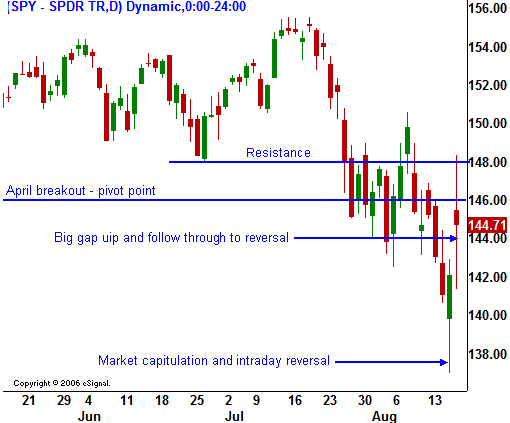Weekly Stock Option Trading Strategy – Look for value and sell out of the money puts.
Here are the nuts and bolts from this week's action. The sell off was caused by loose credit and poor lending decisions. Defaults had a cascading affect and they started a run on short-term debt instruments. That liquidity crunch culminated when T-bill rates dropped 1% this week. That type of move is almost unprecedented.
The squeeze spilled over to brokerage firms and they raised margin requirements to control risk. Instantly, hedge funds that utilize quantitative analysis were forced to liquidate their holdings. They employ a long/short portfolio strategy where they buy value and sell "fluff". Theoretically, they are market neutral. Many financial institutions view this as a conservative strategy and they allow these hedge funds to leverage up to an 8:1 ratio. When brokerage firms change the rules, the hedge funds have to pare their holdings. That is why we saw so many quality stocks get trashed this week. Companies that just announced earnings and raised guidance were pummeled even though they trade at low P/E's.
The sell off Thursday was exacerbated by option expiration sell programs. Regardless, the market staged an impressive intra day reversal without the help of the Fed. Friday morning before the open, the market was down 25 S&P 500 points in response to overseas declines. As the opening approached, the futures were only down 8 points. Clearly, we were near a short-term low. At 7:15 a.m. CST, the Fed lowered the window discount rate to avert a liquidity crunch and the rally was on.
The Fed’s action allowed financial institutions to pledge securities and borrow cash. This allows companies to meet their short-term obligations without having to dump their holdings at artificially depressed prices. The Fed has not had to use this tool for many years.
There are many other leveraged “conservative” strategies like this and when liquidation is forced, the market is thrown out of whack. The yen-carry trade is a widely-cited example. The most important thing to remember is that the macro business conditions remain intact. The adjustment process needs to run its course before everything can return to normal.
The Fed has conveyed that they are aware of current market forces and they are on alert. Next week the economic releases are very light. Retailers make up the majority of earnings announcements and dismal results are priced in. The market has staged back-to-back late day rallies and I believe it will follow through next week. If it can get above SPY 146, that would be a short-term bullish sign.


Daily Bulletin Continues...

